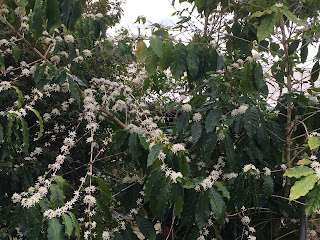Have you ever heard of people arguing about whether a tomato is a fruit or a vegetable? The problem arises because of a difference between the nutritional and the botanical distinction. I can only guess what identifies a vegetable for food or nutritional purposes. Is it because vegetables have this raw, bitter taste to them or is this taste only distinguished by the people who dislike vegetable, like me? I often wondered if the reason I don't like vegetables is because of that different taste.
A fruit, by botanical definition, is a fleshy organ designed to protect and nourish the seed. The seed is the “future” of whichever plant produces the fruit. The fruit developed from the flower.
 |
Flowers from a coffee tree / Aiea Heights yard / April 2016
|
Even the coffee bean (which comes from a fruit called a “cherry”) develops from lovely flowers. [As of today, the coffee “fruit” has not yet appeared on these plants.] Coffee plant information
So many nutritional vegetables are actually botanical fruits. For example, pea and bean pods, full squashes, and of course, the tomato are all botanical fruits. I believe all nutritionally identified fruits are also botanical fruits.
Mankind’s botanical genetic interventions have led to many changes in the nutritionally named fruits and vegetables. This is very evident in the banana.
 |
| Banana fruit and flower / Aiea Heights yard / January 2016 |
The banana fruit is already an interesting fruit as they grow upside down. But in a college genetics class, I learned another interesting fact about bananas. True wild bananas have large seeds in them! I wonder where you could ever find one of those. The banana has been “domesticated” for so long that you can’t grow bananas from the tiny seed remnants you see today.
This is probably true of many fruit plants and actually many ornamental plants too. The plants are not grown with seeds but through cuttings. Some plants can only be grown through cuttings! These plant have no fruit (with seeds) or the seeds are not true seeds thus are not able to grow more of the seed bearing plant if planted.
Some other unusual fruits are nuts. If you picture a coconut or have seen a walnut on a tree, the fleshy outer part, or husk, is the botanical fruit and the fleshy part we eat is the interior of the plant’s seed.
 |
| Palm tree - 1 with fruit / Aiea Heights yard / May 2016 |
 |
| Palm tree - 2 with fruits / Aiea Heights yard / May 2016 |
 |
| Palm tree - 3 with fruit / Aiea Heights yard / May 2016 |
These are three different types of palm trees producing their fruit. I don’t believe any are edible fruit. [As an aside, never eat a plant’s “fruit” unless you are sure it is edible.]
I found it interesting that all of these types of palms were fruiting at the same time! The three different palm plants were all found in two yards next to each other.
On my many runs, or walks, I noticed some other inedible fruits which developed on ornamental yard plants.
 |
| Natal plum / Near Aloha Stadium / February 2016 |
 |
| Mock orange hedge with fruit / Aiea Heights yard/ April 2016 |
 |
| Mock orange fruit / Aiea Heights yard/ April 2016 |
 |
| Acacia flower and pods / Aiea Heights yard/ April 2016 |
And of course, as pea and bean pods are fruit, all those inedible pods found on Hawai’i plants and trees are botanical fruits too! [See March 10, 2016 - Winter flowering plants / trees in Hawai’i ]
So keep "watching out for nature," and see how many different kinds of unusual, or usual, fruit you can see!
No comments:
Post a Comment